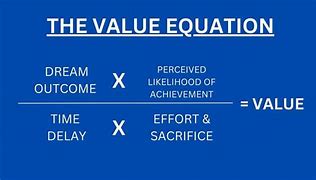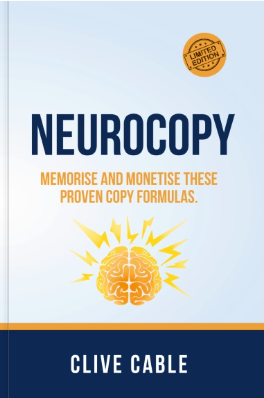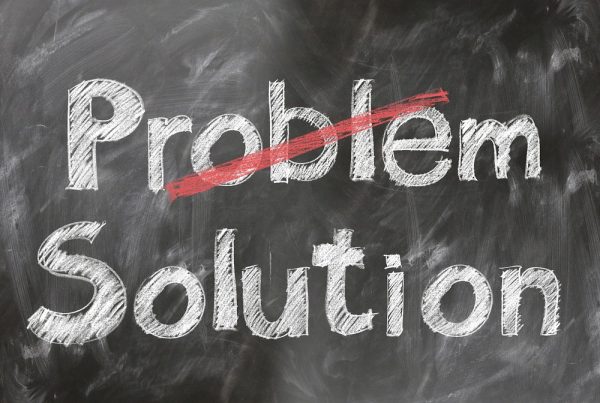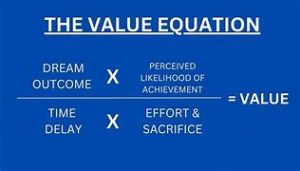Want to know why some offers sell like crazy while others fall flat?
It comes down to a simple formula most business owners never see…
Let me break this down in plain English.
Your dream outcome is what your customer desperately wants. Like dropping 30 pounds, getting their first 100 clients, or fixing their marriage. But here’s the trick – it’s not enough for them to want it. They need to believe they can actually get it.
That’s where likelihood of achievement comes in. The more proof you have that your solution works, the higher this number goes. Case studies, testimonials, and your own results all bump up this score.
Now for the bottom half of the equation. Time delay is simple – how long until they get results? The shorter, the better. And perceived effort? That’s how hard they think it’ll be. The easier you make it sound (while staying honest), the more attractive your offer becomes.
Here’s what this looks like in real life:
A fitness coach promises: “Drop 30 pounds in 90 days with just 20 minutes of exercise, 3 times a week – even if you hate the gym and love pizza.”
Breaking it down:
- Dream outcome: Losing 30 pounds
- Likelihood: High (specific timeframe, reasonable claim)
- Time delay: 90 days (acceptable for the result)
- Perceived effort: Low (only 20 minutes, 3 times weekly)

Scoring Your Current Offer
Get out a piece of paper. Rate each part of your offer from 1-10:
- How badly do people want the outcome? (1-10)
- How believable are your claims? (1-10)
- How quickly do they get results? (1-10)
-
How easy does it seem? (1-10)
Add up your score. Anything under 30 needs work.
Top offers score 35+.
Below 20? Time for a complete overhaul.

Why Your Guarantee Changes Everything
Your guarantee isn’t just some required fine print. It’s rocket fuel for your offer. A strong guarantee shoots up the “likelihood of achievement” score because it removes risk. But most guarantees stink because they’re boring and standard.
The best guarantees are specific and bold. Don’t just say “30-day money back.” Say “Hit £10,000 in new sales within 60 days or it’s free.”
Scarcity & Urgency (Without Being Sleazy)
Real scarcity works. Fake scarcity backfires. Only limit your offer if it’s true:
- You can only handle 10 clients
- The bonus expires when the timer hits zero
- The price goes up next week
Urgency follows the same rule. Don’t create fake deadlines. Instead, show them the cost of waiting:
- Lost revenue every month they delay
- Competitors taking market share
- Problems getting worse over time
Why Create Your Offer Before Writing Copy
Four solid reasons:
- Your offer is the engine, copy is just the paint job
- Great copy can’t fix a weak offer
- Strong offers practically write themselves
- Testing and tweaking is easier when the offer is solid
Why Hire a 35-Year Veteran Copywriter
Two big reasons:
- They’ve seen thousands of offers fail and succeed
-
They know which tweaks create breakthroughs
The Hormozi Four-Part Formula Breakdown
Here’s the thing about Alex Hormozi’s offer formula – it’s dead simple but most people mess it up. Let’s fix that.
Part 1: The Thing They Want
Start with the end result. But don’t just name it – quantify it. Numbers sell. Compare these:
Weak: “Get more clients”
Strong: “Get 10 new high-ticket clients in 30 days”
Your job? Find the specific number your market wants. Not what you think they should want. What they actually want.
Quick tip: Look at your past clients. What numbers did they ask for before buying? That’s your sweet spot.
Part 2: The Timeline
Two rules here:
- Make it believable
- Make it faster than they expect
Most business owners get this backwards. They promise results too fast (killing believability) or too slow (killing desire).
The sweet spot? Take your realistic timeline and cut it by 25%. But only if you can actually deliver. Example:
Regular timeline: “12 months to 7-figures”
Sweet spot timeline: “9 months to 7-figures”
Part 3: The Roadblocks You’ll Remove
This is where most offers get strong legs. List every single thing that usually stops people from getting results. Then eliminate each one.
Common roadblocks:
- No time? Include done-for-you pieces
- No tech skills? Add tech support
- No experience? Provide templates
- No confidence? Add 1-on-1 coaching
The key? Remove more roadblocks than anyone else in your market.
Part 4: Price Anchoring
Here’s where you make your price look tiny compared to the value. Three steps:
- Add up all the components at retail price
- Show the real-world value of the outcome
- Price your offer between these numbers
Example:
Components = £10,000
Outcome value = £100,000
Your price = £25,000
Now the math makes sense: Pay £25k to get £100k = no-brainer.
Putting It All Together
Your offer should read like this:
“Get [specific result] in [timeline], without [biggest roadblock], [second roadblock], or [third roadblock]. Value: £[anchor price]. Today: £[your price]”
Real example:
“Get 10 high-ticket clients in 30 days without cold calling, without paid ads, and without an existing network. Value: £50,000. Today: £5,000”
The Magic Multiplier
Want to make your offer even stronger? Add these:
- Speed bonus (extra value for quick action)
- Implementation bonus (tools to get faster results)
- Scarcity bonus (extra value for first X buyers)
Putting Your Offer Into Action

Time to roll up your sleeves. Here’s your step-by-step plan to build your offer:
Step 1: Market Research Deep Dive
Before touching your offer, spend 3 days:
- Reading customer complaints in Facebook groups
- Studying competitor offers
- Calling 5 past clients
- Writing down exact phrases your market uses
Look for:
- Pain points they mention most
- Results they’re willing to pay for
- Timeframes they expect
- Objections that stop them buying
Step 2: The Value Stack
List everything you could include:
- Main program/product
- Group coaching calls
- Private coaching
- Templates/swipe files
- Software access
- Community access
Now cut anything that:
- Doesn’t speed up results
- Adds complexity
- You can’t deliver consistently
Step 3: Risk Reversal Engineering
Build your guarantee backwards:
- List all buyer fears
- Create guarantee addressing biggest fear
- Add proof you can honor it
- Test it with 5 potential customers
Strong guarantee structure:
“If [specific result] doesn’t happen in [timeline], we’ll [specific action] until it does.”
Step 4: Offer Testing
Test your offer cheap before going big:
- Post in relevant Facebook groups
- Email 20 past customers
- Call 10 potential clients
- Run small ad test
Look for:
- Questions they ask
- Parts they get excited about
- Things they misunderstand
- Price reactions
The Implementation Plan
Week 1:
- Do market research
- Build value stack
- Create guarantee
Week 2:
- Write offer
- Test with small group
- Adjust based on feedback
Week 3:
- Create sales materials
- Set up delivery system
- Train team if needed
Common Offer Killers
Avoid these mistakes:
- Too many components
- Unclear main benefit
- Weak guarantee
- Bad price position
- No urgency/scarcity
Final Success Tips
- Keep testing different versions
- Track conversion rates
- Ask buyers why they bought
- Ask non-buyers why they passed
- Update offer every 90 days
Your Next Steps
Today:
- Score your current offer
- List possible improvements
- Schedule market research
This Week:
- Build new value stack
- Create stronger guarantee
- Test with small group
Next 30 Days:
- Roll out new offer
- Track results
- Adjust as needed
Remember: A great offer needs time to develop. Test small, adjust fast, scale what works.

Want an unfair advantage over 98% of ordinary copywriters?
Forget the basic copy formulas that no longer work. BAB (Before and After Bridge) PAS (Problem Agitate Solve) AIDA (Attention – Interest – Desire – Action) buyers are immune to these.
BUT the 13 ways to intensify desire, the One Belief 10 Questions or the 12 Proof Elements – all sales copy must have are these proven million dollar winners.
They are all here (and more) inside this book.



